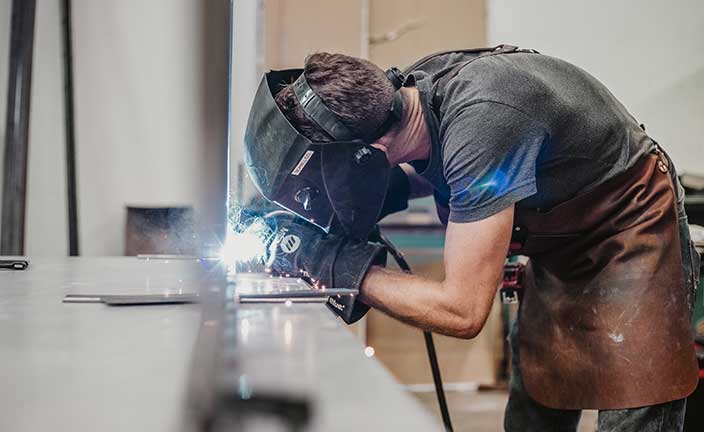What Manufacturing Employers Can Do Now to Fill Jobs
Posted by Penn Foster on July 24, 2019
When the average person thinks about manufacturing, they picture huge multinational corporations with hundreds of employees. However, most manufacturing companies are small businesses with fewer than 20 employees. If you're running one of those small manufacturing facilities, you know first-hand how difficult it can be to find qualified employees.
A small team means even one vacancy can have a major effect on production. You've heard that attitudes toward manufacturing are changing and that technology will revolutionize the manufacturing industry for the better. Maybe those things will eventually help your industry, but they take time. Right now, you have a business to run and not enough hands to do it.
You can't wait around for public opinion, technology, or government regulations to change. Those areas will evolve at their own pace and there's not much you can do to speed up the process. So what can manufacturing employers do to fill jobs now?
Stop waiting for qualified applicants to walk through your door, and start creating your own. By hiring workers new to the manufacturing industry and training them yourself, you not only fill vacant positions today, you also build a robust talent pipeline for the future.

How big is the problem, really?
A SCORE survey found that 89% of manufacturers struggle to fill open positions. Business owners named three reasons for the difficulty:
- Misperceptions - The public at large still thinks of jobs in the manufacturing industry as dirty, dangerous, or low skill. Public misperceptions hinder recruitment of new employees.
- Changing Skills - The essential skills to thrive in the manufacturing industry are changing as a result of new technologies. These technologies could improve manufacturing, but only if employees know how to use them.
- Retirements - Baby boomers are retiring. As a result, many manufacturing employers are losing their most experienced employees.
Vacant positions cost individual manufacturing companies, hundreds and often thousands of dollars a day. Every unfilled position slows the manufacturing process. Remaining team members shoulder more of the load. Eventually, overwork can take its toll, resulting in even more vacancies as employees seek out other opportunities.
And manufacturing companies aren't the only ones to suffer when manufacturing jobs go unfilled. The whole US economy feels the strain. Some estimates calculate that a persistent skills shortage could cost the U.S. up to $2.5 trillion over the next 10 years.
Of course, this isn't news to manufacturing employers. You see the effects of changing skills, misperceptions, and Baby Boomer retirement every day. The question is: What can you do about it?
Manufacturers cannot alter public perception overnight or keep people from retiring when their time comes. They should not refuse technology upgrades that will improve safety, efficiency, and quality of production. So what can they do, right now, today, to fill jobs in manufacturing? The answer lies in training and development.
Why train and develop manufacturing workers.
Offering, and publicizing, employee development programs addresses all three of the major factors affecting the talent pool. Recruitment is easier because you don't have to wait for the perfect candidate to magically appear. You can hire someone with a good attitude and a willingness to learn and train for the skills they need.
When you offer training and development programs or education assistance programs to employees, you refute the image of manufacturing as an old fashioned job lacking in career opportunities. Training and development opportunities help working learners move through the ranks of your business. By offering these opportunities, you show that every employee has a path forward and a way to develop their career.
You can also widen your talent pool. Instead of waiting for candidates who already have the right skills and experience, you can hire newcomers to the industry and train them for the skill sets you need.
Training and development also tackles technology challenges by training working learners in essential skills. If the training is continuous throughout their career, they never fall behind the technology curve. This allows workers, and your business to stay on the cutting edge of technology.
Finally, apprenticeship programs create opportunities for retiring team members to pass on their knowledge before it's too late. Instead of letting their experience walk out the door with them, you create a mechanism for them to share their wealth of knowledge with more junior coworkers.
Methods for training and development to fill jobs.
There are many ways to structure training and development programs to fill manufacturing jobs. Each business must find the mix that works for them. An experienced education partner can help you decide on the mix of training and development opportunities to support your growing workforce.
Apprenticeships - Apprenticeship programs combine classwork with on the job training under senior team members. Give new employees both the theoretical knowledge and the practical skills to do the job with this high-impact learning opportunity.
Online Learning - Courses in safety, management, and other essentials can be taught online so working learners can grow their knowledge without taking time off from work. Get your new hires on the production floor quickly and let them develop skills at their own pace. Online learning is convenient and easy to access, especially when it's mobile enabled.
Skills Playlists - Some new employees need focused training in specific skill sets. Skills playlists can help bring new employees up to speed quickly. They can be customized to meet the specific needs of your business and it's working learners.
Penn Foster offers a full spectrum of training and development solutions for manufacturing employers. Rely on our expertise to find the right solution to fill your open positions. Contact us today for a needs assessment.